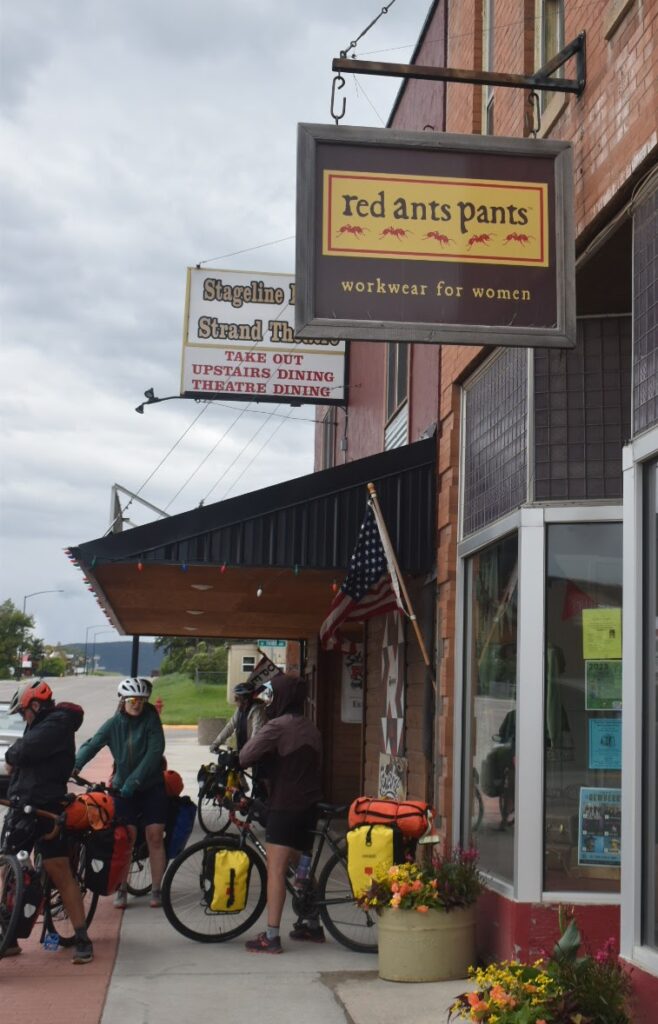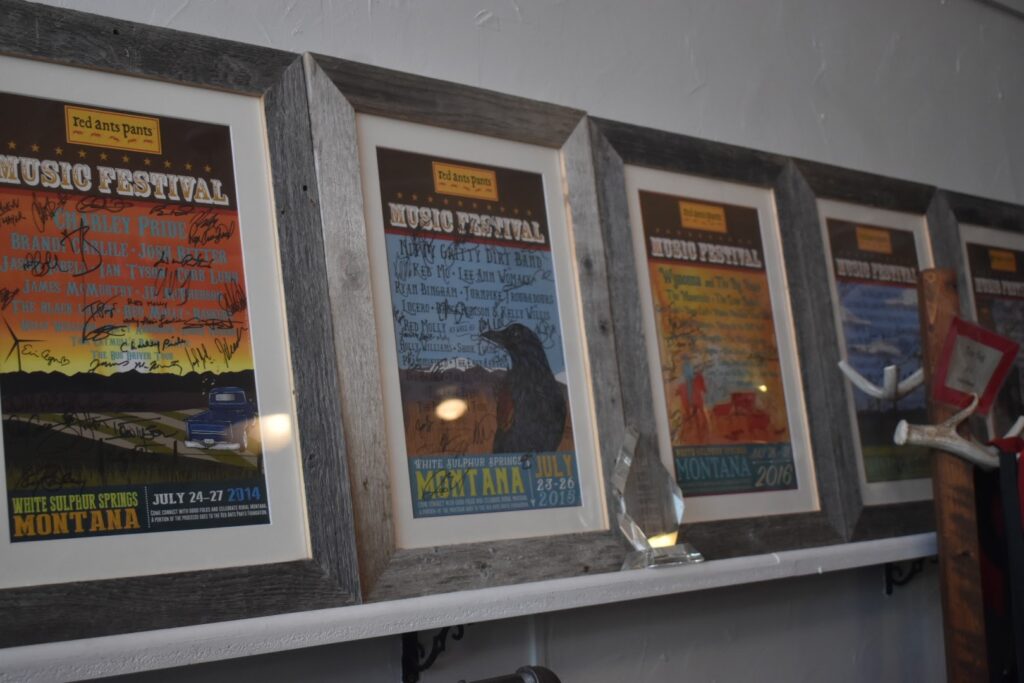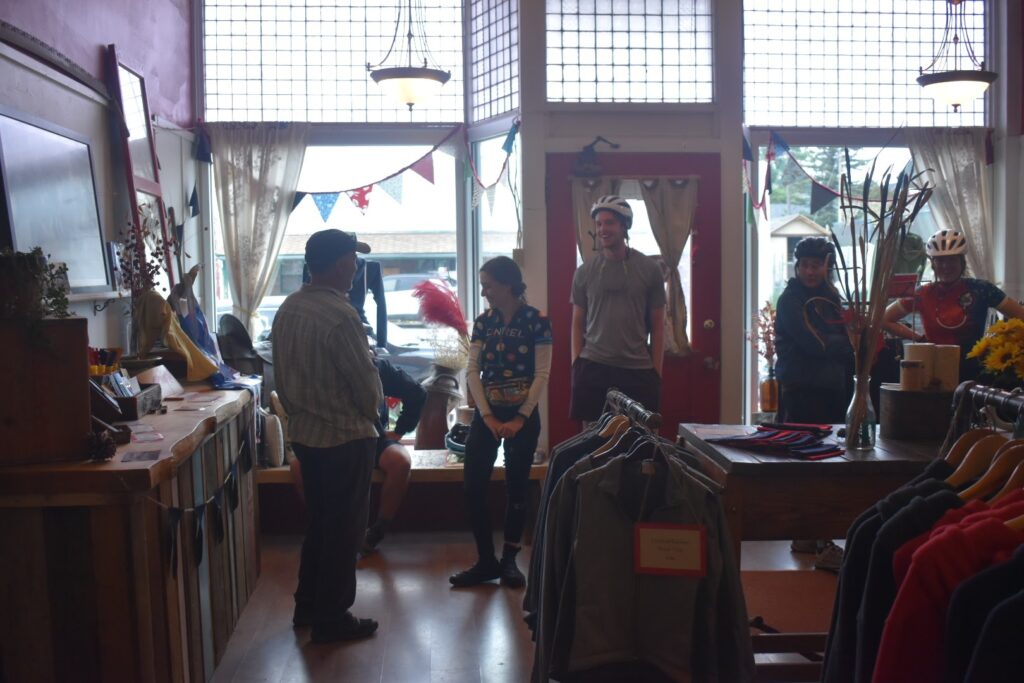What’s Shaking in White Sulphur Springs? Embracing spontaneity to lever climate action
By Emma Hamilton (CTR ’23)
After a week of cycling across Montana, I left the Spa Hot Springs Motel in White Sulphur Springs on a cool Wednesday evening, feeling relieved of some of my aches and pains. I was finally starting to feel my big toes, which had gone numb from over 230 miles of cycling, as I walked along the Main Street in town with my cyclist friends. We were discussing the best way to eat our three cartons of Wilcoxson’s — Montana’s finest ice cream — when low, rhythmic booming sounds began to override our very important conversation. I turned towards the sound and saw a group of people, a mix of children and adults, underneath a small bandstand at the town park. Sure enough, they were drumming in the middle of town, which is something that I haven’t observed in towns I’ve called home.
[Drumming in White Sulphur Springs] Music seems to have played a significant role in strengthening the community and economic growth in White Sulphur Springs over the past decade. The first stop we made when we got into the town was Red Ants Pants, a local business founded in 2006 by Sarah Calhoun that makes workwear for women. Five years later, Sarah and her Red Ants Pants crew started the Red Ants Pants Music Festival. Today, the annual festival brings 15,000 people together and has hosted some of my favorite big names, like Lucinda Williams and Patty Griffin. The festival’s website notes that “a little Made in the USA pants company” starting a musical festival may not be the “usual path for a small business, but why not?”
Music seems to have played a significant role in strengthening the community and economic growth in White Sulphur Springs over the past decade. The first stop we made when we got into the town was Red Ants Pants, a local business founded in 2006 by Sarah Calhoun that makes workwear for women. Five years later, Sarah and her Red Ants Pants crew started the Red Ants Pants Music Festival. Today, the annual festival brings 15,000 people together and has hosted some of my favorite big names, like Lucinda Williams and Patty Griffin. The festival’s website notes that “a little Made in the USA pants company” starting a musical festival may not be the “usual path for a small business, but why not?”
The energy that emerged from the drumming I observed one evening and the Red Ants Pants Music Festival in the town of White Sulphur Springs inspired my own processing of what might emerge from spontaneous acts in the context of the climate crisis.
I have noticed a similar aura of spontaneity driving climate action already. For instance, Greta Thunberg mobilized a global youth climate movement when she refused to attend school and sat outside in protest in 2018. While I’m not certain if Thunberg foresaw the global impact of her unconventional actions, they certainly reveal that a bit of spontaneity may catalyze new ways of knowing and being.
I think it’s important to note that advocating for spontaneity is not advocating for complete chaos, nor does it ignore the strategic planning that is often involved in planning events, like protests and music festivals. I’m not suggesting that we release sulfur dioxide-filled weather balloons in the sky just to see what happens, although that is already happening, but I think spontaneity could be a useful tool in some cases for opening our minds to consider what might otherwise seem impossible.

A few days after our visit to White Sulphur Springs, we met with Diana Hammer and Mark Juedeman from Resilient Helena, a non-profit that works to build local environmental resilience in Helena, Montana. When discussing the complex problems that emerge from mitigating the climate crisis, Hammer said, “We can solve them, we just need to start more.”
Embracing spontaneity might help us “start more.” However, I find that there isn’t much time to be spontaneous. As a college student, my life feels tied to a predictable schedule with classes, assignments, exams, student organizations, and a part-time job, with a little room squeezed in here and there for meals, family, friends, and hobbies. While sticking to a daily routine can feel comfortable, I often wish I had more time — not only for fun, but also to participate in environmental activism that will create a positive change towards a world that we all want to live in, which should be fun, too.
Routines are easy and comfortable, but mitigating the climate crisis is challenging and uncomfortable. Perhaps adding a bit of spontaneity to our lives, although uncomfortable at first, may help us feel a little less stuck in our current routines and a little more open to changes in the climate and how we respond to them.

In other words, changing up our routines might allow for more space in our busy schedules to acknowledge and act on the climate crisis. On this course so far, I’ve had the opportunity to learn about other ways people have become involved in energy and climate issues; like testifying in court to uphold Montanans’ right to a “clean and healthful environment” (the youth plaintiffs from Held v. Montana); like creating and performing plays about renewable energy (Elizabeth Wood and the New Western Energy Show); and like skipping school to protest the climate crisis. None of these acts sound part of the average person’s daily routine, nor do they seem easy, but what if they happened more? While these unconventional acts may seem deeply personal and challenging, I believe they are important if we are to mitigate a deeply personal and challenging issue like the climate crisis; and they may even inspire others to act, too.

Once I learned about Red Ants Pants in White Sulphur Springs, I realized that I had purchased a used Red Ants Pants t-shirt from a local thrift store in Ely, Minnesota years ago. However that t-shirt made its way from western Montana to northeastern Minnesota, I am amazed not only by the local impact but also the national reach of Red Ants Pants. My observations and interactions in the ever-booming town inspired me to ultimately ask how I might embrace the uncertainties and possibilities that come with mitigating the climate crisis and spontaneous climate action in my own life.
Cover photo by CTR student Gretchen Casper: Ella Vander Veld takes a spontaneous, and glorious, dip on a break from riding.